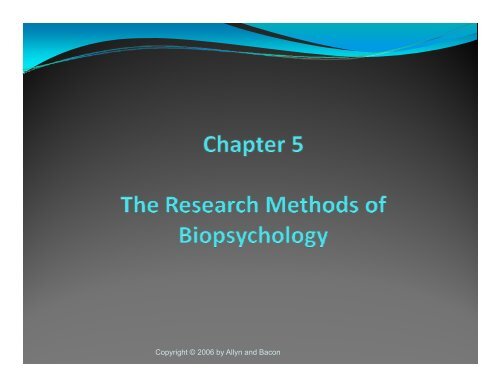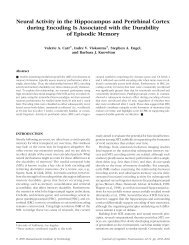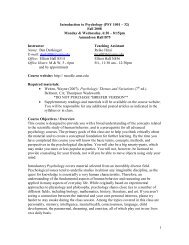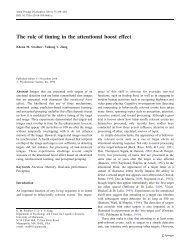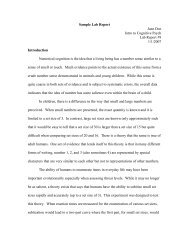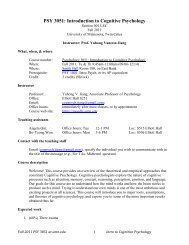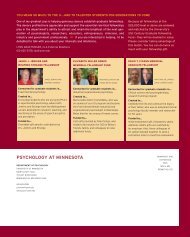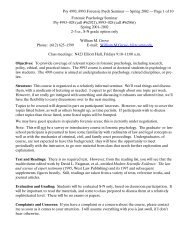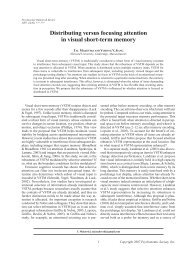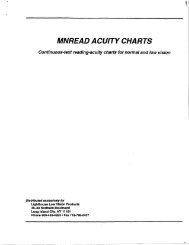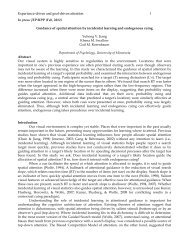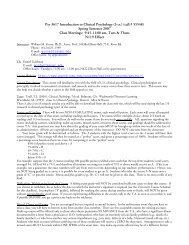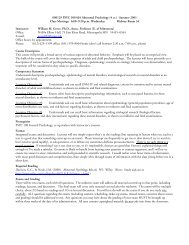Chapter 5 slides
Chapter 5 slides
Chapter 5 slides
Create successful ePaper yourself
Turn your PDF publications into a flip-book with our unique Google optimized e-Paper software.
Copyright © 2006 by Allyn and Bacon
Methods of Visualizing the Living Human<br />
Brain ‐ Structure<br />
• Contrast X‐Rays –Abeam of x‐rays is passed through body onto a<br />
photographic plate. A contrast medium absorbs X‐rays less or more<br />
than surrounding tissue and can be injected into an area of interest.<br />
• Eg E.g., cerebral angiography<br />
• X‐Ray Computed Tomography (CT)<br />
• 2‐D images combined to create a 3‐D one<br />
*X‐rays can be used for visualizing vasculature, and hence for<br />
assessing stroke location and extensiveness, but are not useful for<br />
examining brain tissue.*<br />
• Magnetic Resonance Imaging (MRI)<br />
• Measures waves emitted by hydrogen atoms when they are activated<br />
by radio waves while in a magnetic field. The waves the atoms give<br />
off differ in frequency depending on the material of which they are<br />
a part (e.g., fat vs. water).<br />
• Produces 3‐D images with high spatial resolution<br />
Copyright © 2006 by Allyn and Bacon
Cerebral Angiography
3‐D movie of Cerebral Angiography<br />
• http://www.med.harvard.edu/AANLIB/cases/case17/<br />
mra.mpg
CT Scan
MRI Scan
Methods of Visualizing the Living Human<br />
Brain ‐ Functional<br />
• Positron Emission Tomography (PET)<br />
• Inject radioactive 2‐DG. This form of glucose is taken up by active<br />
cells and accumulates. Radioactivity is mapped to reveal activity.<br />
• Functional MRI (fMRI)<br />
• MRI technology that focuses on oxygen flow in the brain. Can<br />
provide info on both activity and structure.<br />
• Magnetoencephalography (MEG)<br />
• Measures changes in magnetic fields on scalp produced by<br />
underlying brain activity. It can record fast changes in activity over<br />
time (temporal resolution).<br />
Copyright © 2006 by Allyn and Bacon
PET Scans<br />
20 yr old brain 80 yr old brain
Functional MRI (fMRI)
Magnetoencephalography (MEG)
fMRI Vs PET<br />
• Nothing injected.<br />
• Provides both structural and functional<br />
information in one image<br />
• Spatial resolution is better than with PET (Note<br />
that MEG has better temporal resolution)<br />
• Can create 3‐D images of activity over the<br />
entire brain<br />
Copyright © 2006 by Allyn and Bacon
Recording Human Psychophysiological<br />
Activity<br />
• Recording physiological activity from the body<br />
surface<br />
• Electroencephalogram (EEG)<br />
• Muscle tension and eye movement<br />
• Skin conductance and cardiovascular activity<br />
Copyright © 2006 by Allyn and Bacon
EEG –measuring “brain waves”<br />
• A measure of the average electrical activity of the<br />
brain.<br />
• Some EEG wave forms associated with:<br />
• Specific states of consciousness<br />
• Cerebral pathology gy( (such as epilepsy)<br />
p • Event‐related potentials may also be of interest<br />
• EEG measured while the person engages in a<br />
particular activity (event)<br />
• For an example of how these are used, go to Ch<br />
.5 on the textbook cd and select “Visit to a<br />
cognitive neuroscience lab”<br />
Copyright © 2006 by Allyn and Bacon
Copyright © 2006 by Allyn and Bacon
Copyright © 2006 by Allyn and Bacon
Measures of Somatic Nervous System<br />
Activity<br />
• Electromyography – muscle tension<br />
• Resulting electromyogram (EMG) can be used as a<br />
measure of psychological arousal<br />
• Electrooculography – eye movement<br />
• Electrooculogram (EOG)<br />
Copyright © 2006 by Allyn and Bacon
Copyright © 2006 by Allyn and Bacon
• Figure 5.13<br />
Copyright © 2006 by Allyn and Bacon
Measures of Autonomic Nervous System<br />
Activity<br />
• Electrodermal – appears to reflect activity of<br />
sweat glands<br />
• Skin conductance level (SCL) ‐ background<br />
• Skin conductance response (SCR) –measures<br />
transient t changes<br />
• Cardiovascular – blood vessels and heart<br />
• Heart rate<br />
• Blood pressure<br />
• Blood volume<br />
Copyright © 2006 by Allyn and Bacon
Measures of Autonomic Nervous System<br />
Activity ‐ Cardiovascular<br />
• Heart rate<br />
• Electrocardiogram (ECG, EKG) records electrical<br />
signals associated with heartbeats<br />
• Blood pressure<br />
• Measured with a sphygmomanometer<br />
• Blood volume<br />
• Plethysmography refers to techniques for measuring<br />
changes in blood volume in a particular body part<br />
Copyright © 2006 by Allyn and Bacon
Polygraph Device:<br />
Heart rate, blood pressure, respiration,<br />
galvanic skin response
Invasive Physiological Research Methods<br />
• Animal research<br />
• Lesioning<br />
• Electrical stimulation<br />
• Invasive recording methods<br />
• Manipulating or measuring within the brain<br />
Copyright © 2006 by Allyn and Bacon
Stereotaxic Surgery<br />
• Used to position experimental devices within<br />
the brain<br />
• Stereotaxic atlas –provides coordinates for<br />
locating structures within the brain<br />
• Bregma – a point on the top of the skull often<br />
used as a reference point<br />
• Sterotaxic instrument –used to hold head<br />
steady and guide the device to be inserted<br />
Copyright © 2006 by Allyn and Bacon
Copyright © 2006 by Allyn and Bacon
Lesion Methods<br />
• Remove, damage, or destroy a part of the brain<br />
to observe impact on behavior<br />
• Aspiration lesions –suction ‐ cortex<br />
• Radio‐frequency lesions – heat destroys tissue<br />
• Knife cuts – may damage surrounding area<br />
• Cryogenic blockade – “reversible lesion”<br />
Copyright © 2006 by Allyn and Bacon
Copyright © 2006 by Allyn and Bacon
Copyright © 2006 by Allyn and Bacon
Electrical Stimulation<br />
• Lesioning can be used to remove, damage, or<br />
inactivate a structure.<br />
• Electrical ca stimulation may be used to “activate” a<br />
structure.<br />
• Stimulation of a structure may have an effect opposite<br />
to that seen when the structure is lesioned.<br />
Copyright © 2006 by Allyn and Bacon
Invasive Electrophysiological Recording<br />
Methods<br />
• Intracellular unit recording<br />
• Membrane epotential t of a neuron<br />
• Extracellular unit recording<br />
• Firing of a neuron<br />
• Multiple‐unit recording<br />
• Firing of many neurons<br />
• Invasive EEG recording – electrodes are implanted in<br />
skull or tissue.<br />
Copyright © 2006 by Allyn and Bacon
Copyright © 2006 by Allyn and Bacon
Pharmacological Research Methods<br />
• Routes of drug administration<br />
• Selective chemical lesions<br />
• Measuring chemical activity in the brain<br />
• Locating neurotransmitters and receptors<br />
Copyright © 2006 by Allyn and Bacon
Routes of Drug Administration<br />
• Fed to the stomach<br />
• Injected ‐ described by injection sight:<br />
• stomach (intragastric)<br />
• peritoneal cavity (intraperitoneal, i IP)<br />
• large muscle (intramuscular, IM)<br />
• tissue under the skin (subcutaneous, sc)<br />
• large surface vein (intravenous, IV)<br />
• Cannula – used to administer drug directly to brain<br />
Copyright © 2006 by Allyn and Bacon
Selective Chemical Lesions<br />
• Neural poisons (neurotoxins) selectively<br />
target specific nervous system components<br />
• Kainic or ibotenic acid – destroy cell bodies<br />
• 6‐hydroxydopamine (6‐OHDA) – destroys<br />
noradrenergic and dopaminergicneurons<br />
i<br />
Copyright © 2006 by Allyn and Bacon
Measuring Chemical Activity of the Brain<br />
• 2‐Deoxyglucose (2‐DG) technique<br />
• Inject animal with radioactive 2‐DG and allow it<br />
to engage in behavior of interest<br />
• Use autoradiography to see where radioactivity<br />
accumulates in brain slices<br />
• Cerebral dialysis – measures extracellular<br />
concentration of specific chemicals in live<br />
animals<br />
Copyright © 2006 by Allyn and Bacon
Locating Neurotransmitters and Receptors<br />
• Dye or radioactive labels used to visualize the<br />
protein of interest<br />
• Immunocytochemistry y–based on the binding of<br />
labeled protein‐specific antibodies<br />
• Immune response ‐ Antibodies created that bind and<br />
remove/destroy antigens (foreign proteins)<br />
• In situ hybridization –uses labeled RNA to locate<br />
neurons with complementary mRNA<br />
Copyright © 2006 by Allyn and Bacon
Genetic Engineering<br />
• Gene knockout techniques<br />
• Subjects missing a given gene can provide insight<br />
into what the gene controls<br />
• Difficult to interpret results – most behavior is<br />
controlled by many genes and removing one gene<br />
may alter the expression of others<br />
• Gene replacement techniques<br />
• Both are currently being intensely studied<br />
Copyright © 2006 by Allyn and Bacon
Neuropsychological Testing<br />
• Time‐consuming ‐ only conducted on a small<br />
portion of those with brain damage<br />
• Assists in diagnosing neural disorders.<br />
• Serves as a basis for counseling/caring<br />
• Provides information on baseline function<br />
Copyright © 2006 by Allyn and Bacon
Approaches to Neuropsychological Testing<br />
• Single‐test – Early approach<br />
• Used to differentiate brain damage from functional<br />
(psychological) causes<br />
• Standardized‐test‐battery<br />
test • Same goal as single‐test approach<br />
• Customized‐test‐battery<br />
• attempts to characterize (describe) the psychological deficits<br />
of a person, rather than just detect whether or not there is<br />
brain damage.<br />
Copyright © 2006 by Allyn and Bacon
Customized‐Test‐Battery Approach<br />
• Began to be used in the 1960’s<br />
• Goal is to characterize the nature of the deficits seen in<br />
the eba brain‐damaged aged patient<br />
t<br />
• Begin with a general test and then follow with tests<br />
designed to explore the nature of the observed<br />
problems<br />
Copyright © 2006 by Allyn and Bacon
Potential Components of the Initial<br />
Common Test Battery<br />
• Wechsler Adult Intelligence Scale<br />
• WAIS, an IQ test<br />
• Often fails to detect memory deficits<br />
• Token test<br />
• Can detect language‐related deficits<br />
• Language g lateralization –used to identify language‐<br />
g<br />
dominant hemisphere<br />
• Sodium amytal – anesthetize one hemisphere<br />
• Dichotic listening –ear contralateral to dominant hemisphere<br />
shows s superior hearing ability<br />
Copyright © 2006 by Allyn and Bacon
Specific Neuropsychological Tests<br />
• Memory –exploring nature of deficits<br />
• Short‐term, long‐term, or both?<br />
• Anterograde or retrograde?<br />
• Semantic or episodic?<br />
• Explicit or implicit?<br />
• Language –problems of phonology, syntax, or<br />
semantics?<br />
• Frontal‐lobe function – often assessed with the<br />
Wisconsin Card Sorting Test<br />
• Can the subject alter strategy as needed? dd?<br />
Copyright © 2006 by Allyn and Bacon
WCST<br />
• Wisconsin<br />
• Card<br />
• Sorting<br />
• Task<br />
Copyright © 2006 by Allyn and Bacon
Cognitive neuroscience – assumptions<br />
• Each complex cognitive process results from the<br />
combined activity of simple cognitive processes<br />
(constituent cognitive processes)<br />
• Each complex cognitive process is mediated by neural<br />
activity in a particular area of the brain<br />
Copyright © 2006 by Allyn and Bacon
Cognitive Neuroscience<br />
• Goal is to identify the parts of the brain that mediate<br />
various constituent cognitive ii processes<br />
• Pi Paired‐image di subtraction technique –compare PET or<br />
fMRI images during several different cognitive tasks<br />
Copyright © 2006 by Allyn and Bacon
Behavioral Paradigms<br />
• Procedures developed for the investigation of a<br />
particular behavioral phenomenon<br />
• Assessment of species‐common common behaviors<br />
• Traditional conditioning paradigms<br />
• Seminatural animal learning paradigms<br />
Copyright © 2006 by Allyn and Bacon
Assessment of Species‐Common Behaviors<br />
• Assessment of behaviors displayed by all members<br />
of a species<br />
• Open‐field test – general activity<br />
• Colony‐intruder paradigm – aggression and<br />
defensive behavior<br />
• Elevated plus maze –anxiety<br />
• Tests of sexual behavior<br />
Copyright © 2006 by Allyn and Bacon
Open Field
Elevated Plus Maze
Traditional Conditioning Paradigms<br />
• Pavlovian conditioning<br />
• Pairing an unconditioned stimulus with a<br />
conditioned stimulus<br />
• Pavlov’s dogs<br />
• Operant conditioning<br />
• Reinforcement and punishment<br />
• Self‐stimulation<br />
• Animal works for electrical stimulation<br />
Copyright © 2006 by Allyn and Bacon
Seminatural Learning Paradigms<br />
Mimic situations that an animal might encounter in<br />
its natural environment<br />
• Conditioned taste aversion<br />
• Pairing something that makes an animal ill (emetic) with a<br />
taste<br />
• Challenged existing assumptions about conditioning<br />
• Animals appear prepared to associate tastes and illness<br />
• Radial arm maze –tests spatial abilities<br />
Copyright © 2006 by Allyn and Bacon
Radial Arm Maze
Seminatural Learning Paradigms<br />
• Morris water maze – tests spatial abilities<br />
• Rat must find hidden platform in an opaque pool<br />
• Conditioned defensive burying – following a<br />
single aversive stimulus delivered from an<br />
object, rats will spray bedding at the object<br />
• Antianxiety drugs decrease the amount of burying<br />
behavior<br />
Copyright © 2006 by Allyn and Bacon
Morris Water Maze


